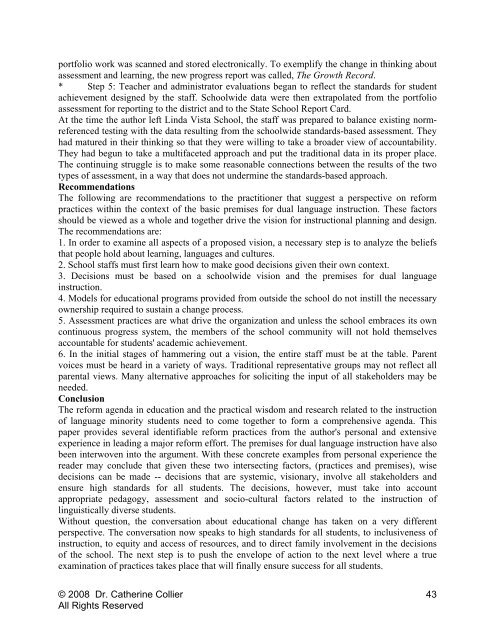Art Un ticle I.1 ited Sta In the ates News - Woodring College of ...
Art Un ticle I.1 ited Sta In the ates News - Woodring College of ...
Art Un ticle I.1 ited Sta In the ates News - Woodring College of ...
- No tags were found...
You also want an ePaper? Increase the reach of your titles
YUMPU automatically turns print PDFs into web optimized ePapers that Google loves.
portfolio work was scanned and stored electronically. To exemplify <strong>the</strong> change in thinking aboutassessment and learning, <strong>the</strong> new progress report was called, The Growth Record.* Step 5: Teacher and administrator evaluations began to reflect <strong>the</strong> standards for studentachievement designed by <strong>the</strong> staff. Schoolwide data were <strong>the</strong>n extrapolated from <strong>the</strong> portfolioassessment for reporting to <strong>the</strong> district and to <strong>the</strong> <strong>Sta</strong>te School Report Card.At <strong>the</strong> time <strong>the</strong> author left Linda Vista School, <strong>the</strong> staff was prepared to balance existing normreferencedtesting with <strong>the</strong> data resulting from <strong>the</strong> schoolwide standards-based assessment. Theyhad matured in <strong>the</strong>ir thinking so that <strong>the</strong>y were willing to take a broader view <strong>of</strong> accountability.They had begun to take a multifaceted approach and put <strong>the</strong> traditional data in its proper place.The continuing struggle is to make some reasonable connections between <strong>the</strong> results <strong>of</strong> <strong>the</strong> twotypes <strong>of</strong> assessment, in a way that does not undermine <strong>the</strong> standards-based approach.RecommendationsThe following are recommendations to <strong>the</strong> practitioner that suggest a perspective on reformpractices within <strong>the</strong> context <strong>of</strong> <strong>the</strong> basic premises for dual language instruction. These factorsshould be viewed as a whole and toge<strong>the</strong>r drive <strong>the</strong> vision for instructional planning and design.The recommendations are:1. <strong>In</strong> order to examine all aspects <strong>of</strong> a proposed vision, a necessary step is to analyze <strong>the</strong> beliefsthat people hold about learning, languages and cultures.2. School staffs must first learn how to make good decisions given <strong>the</strong>ir own context.3. Decisions must be based on a schoolwide vision and <strong>the</strong> premises for dual languageinstruction.4. Models for educational programs provided from outside <strong>the</strong> school do not instill <strong>the</strong> necessaryownership required to sustain a change process.5. Assessment practices are what drive <strong>the</strong> organization and unless <strong>the</strong> school embraces its owncontinuous progress system, <strong>the</strong> members <strong>of</strong> <strong>the</strong> school community will not hold <strong>the</strong>mselvesaccountable for students' academic achievement.6. <strong>In</strong> <strong>the</strong> initial stages <strong>of</strong> hammering out a vision, <strong>the</strong> entire staff must be at <strong>the</strong> table. Parentvoices must be heard in a variety <strong>of</strong> ways. Traditional representative groups may not reflect allparental views. Many alternative approaches for soliciting <strong>the</strong> input <strong>of</strong> all stakeholders may beneeded.ConclusionThe reform agenda in education and <strong>the</strong> practical wisdom and research related to <strong>the</strong> instruction<strong>of</strong> language minority students need to come toge<strong>the</strong>r to form a comprehensive agenda. Thispaper provides several identifiable reform practices from <strong>the</strong> author's personal and extensiveexperience in leading a major reform effort. The premises for dual language instruction have alsobeen interwoven into <strong>the</strong> argument. With <strong>the</strong>se concrete examples from personal experience <strong>the</strong>reader may conclude that given <strong>the</strong>se two intersecting factors, (practices and premises), wisedecisions can be made -- decisions that are systemic, visionary, involve all stakeholders andensure high standards for all students. The decisions, however, must take into accountappropriate pedagogy, assessment and socio-cultural factors related to <strong>the</strong> instruction <strong>of</strong>linguistically diverse students.Without question, <strong>the</strong> conversation about educational change has taken on a very differentperspective. The conversation now speaks to high standards for all students, to inclusiveness <strong>of</strong>instruction, to equity and access <strong>of</strong> resources, and to direct family involvement in <strong>the</strong> decisions<strong>of</strong> <strong>the</strong> school. The next step is to push <strong>the</strong> envelope <strong>of</strong> action to <strong>the</strong> next level where a trueexamination <strong>of</strong> practices takes place that will finally ensure success for all students.© 2008 Dr. Ca<strong>the</strong>rine CollierAll Rights Reserved43
















